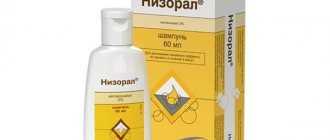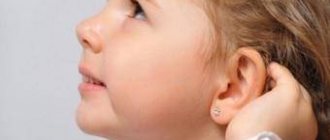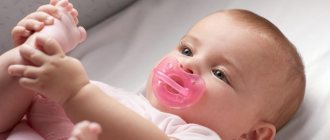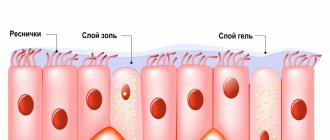The facial skull has several cavities called paranasal sinuses. They are located in the ethmoid, frontal, sphenoid bones and the upper jaw. All of them are involved in cleaning, warming and humidifying the inhaled air, and regulate pressure in the respiratory tract. Inflammation of the mucous membrane of the paranasal sinuses is called sinusitis. Factors contributing to the development of sinusitis are:
- hypothermia of the body;
- untimely treatment of runny nose and ARVI;
- congenital and acquired defects in the structure of the bones of the facial skull;
- reduced immunity.
All these factors can contribute to the development of frontal sinusitis - inflammation of one or both sinuses of the frontal bone. It is characterized by intense headache and the risk of developing serious complications.
This disease affects both adults and children.
Features of frontal sinusitis in children
Newborns and babies in the first months of life do not suffer from frontal sinuses at all, because the frontal sinuses are absent at birth and develop throughout life as the bones of the skull grow. The disease begins to occur in children over 6 years of age.
This disease should be suspected if a child complains of a severe headache, mainly in the forehead. Moodiness, tearfulness and irritability appear. The child loses interest in games and cannot concentrate on studies.
Since the frontal sinuses are involved in the formation of voice timbre, their swelling often leads to nasal sound.
Classic symptoms of frontal sinusitis:
- pain and heaviness in the forehead, on one or both sides, often throbbing;
- pain in the inner corner of the eye, worsens in the morning and with pressure;
- photophobia, excessive tearing as a reaction to light;
- decreased sensitivity to smells up to complete loss of smell;
- redness and thickening of the upper eyelid, swelling of the nose and brow ridges;
- mucous discharge at the beginning of the disease, later acquires a purulent character and an unpleasant odor;
- nasal congestion to the point of impossibility of nasal breathing, especially at night;
- increase in body temperature to 37.5-38.5 ° C, sometimes higher;
- phenomena of general intoxication - weakness, malaise, sweating, loss of appetite, poor sleep.
Based on these signs, you may suspect acute frontal sinusitis yourself. However, meningitis, encephalitis, neurological pathology and other sinusitis may have similar symptoms. In any case, if a child presents such complaints, he should be shown to a pediatrician or ENT doctor as soon as possible.
What to do if your child has allergic rhinitis?
15.12.2020
Nowadays, an increasing number of people suffer from various allergic diseases. One of the most common among them is allergic rhinitis , or, as it is also called, hay fever . Unfortunately, many children suffer from this disease. Some people often have “water” flowing from their nose, others have itchy eyes and nose , sneezing, others have a cough, a sore throat or the nose .
For children with seasonal allergies , these symptoms may appear in the spring or summer when trees, grasses, or flowers are in bloom. For others allergies are independent of the seasons because they are caused by house dust and mites, mold, or pet dander.
The danger of allergies is that they can provoke infectious diseases of the nasopharynx and ears and aggravate asthmatic symptoms. It also negatively affects the child’s ability to concentrate during learning, impairs memory, and increases fatigue at the slightest load.
How to cure hay fever?
In order not to expose your children to the risk of exacerbation of allergies , you need, first of all, to keep your home clean. You need to get rid of everything that can accumulate dust: curtains, upholstery, carpets, rugs, etc. All pillows, duvets, and mattresses must have plastic anti-allergenic covers. Change bedding every week and wash soft toys in hot water. If there are pets in the house, try to ensure that the child has contact with them as little as possible, do not allow them to be in the children's room, and bathe them weekly. Remember, mold is also very dangerous for a child, especially for those with allergies . Constantly check all places where it is damp and where mold may appear. If detected, immediately take measures to eliminate it.
Vacuum as often as possible, but only in the absence of the child, since some of the dust gets back into the room, and it is in it that allergy . Fans should always have clean filters. It is not advisable to use ceiling ventilation in the apartment.
In the spring, when the trees are blooming, and in the summer when the grasses are blooming, try to let your child go outside as little as possible. During this period, windows both in the apartment and in the car should be closed. This precaution is necessary to prevent pollen from entering the house or car while a child is in it. Avoid exposing your baby to cigarette smoke. After all, with allergic rhinitis, he already has difficulty breathing.
Medicines for allergic rhinitis
Medications such as antihistamines, steroids and decongestants are known to be used for allergy If your child experiences an exacerbation of the symptoms of the disease, contact a specialist, and the doctor will write you a prescription for more potent medications.
Allergy medications will be effective only if the child takes them daily for the entire period until the season ends. If the child does not have hay fever , but allergy , then it is very possible that the child will have to take the medicine all year.
To free your sinuses from mucus and relieve inflammation, put in your nose 3 times a day. A solution of table sea salt is best suited for this.
Recommendations
Always be especially attentive to a child suffering from allergic rhinitis . If nothing helps have been treating a doctor who should prescribe him new medications. A visit to the clinic greenish nasal discharge
If the measures taken do not help cure the child, he should be taken to see an allergist . He will prescribe the necessary tests that will help make a diagnosis, indicating exactly what is the allergen for your child. The specialist will prescribe more serious treatment that will help your child be healthy.
Published in Allergology Premium Clinic
Types and classification of frontites
The symptoms described above are characteristic of the acute form - when the disease develops in a few days and disappears without a trace in less than 1 month.
With a weakened immune system and insufficient treatment, the inflammatory process may become chronic. With a continuous course, the disease takes on a less pronounced form, its symptoms weaken, but do not disappear:
- headache occurs at night;
- runny nose and nasal congestion do not go away, vasoconstrictor drugs lose their effectiveness;
- cough with sputum is often associated;
- In the morning, redness and swelling of the eyes and watery eyes appear.
All this is accompanied by symptoms of asthenia - the child becomes lethargic, lethargic, and his academic performance drops.
The recurrent form is characterized by alternating stages of exacerbation and remission. In this case, the signs of frontal sinusitis may completely disappear, but with any hypothermia and colds, as well as in the off-season, the picture of an acute illness returns.
A special variant of the disease is allergic frontal sinusitis. This form develops as a complication of chronic allergic rhinitis. When the mucous membrane of the nasal cavity is constantly inflamed and swollen, the ventilation of the paranasal sinuses and the outflow of secretions from them are disrupted. This promotes stagnation and increases the likelihood of infection. The main treatment in this situation is aimed at combating allergens.
Causes of swelling and its elimination
Let's take a closer look at the reasons that lead to the development of swelling of the nasal mucosa and the methods of its treatment.
- Infection. One of the possible causes of swelling of the nasal mucosa is a viral or bacterial infection. In this case, the disease may manifest itself only as nasal congestion, or discharge may be added to the congestion. For treatment, it is necessary to rinse the nasal cavity with saline solutions; in some cases, local antiseptic and antibacterial drugs are added to the treatment.
- Allergy. House dust mites, plant pollens, and components of household chemicals provoke allergic inflammation of the nasal mucosa. It manifests itself in constant sneezing, runny nose and headache. The nose swells, turns red, and becomes painful when touched - especially if you blow your nose too often and forcefully. Allergic diseases do not go away without taking antihistamines. For symptomatic treatment, pharmaceutical and folk remedies are used. If you have a stuffy nose due to allergies, inhalation without the use of essential oils and rinsing with saline help relieve swelling.
- Acute or chronic sinusitis. One of the most unpleasant symptoms of the disease is a runny nose caused by inflammation of the paranasal sinuses. How to relieve nasal swelling with a runny nose caused by acute sinusitis? Treatment with antibiotics, painkillers and drugs that will help quickly reduce swelling in the nasal cavity is indicated - for example, vasoconstrictors. Regular rinsing of the nasal cavity allows you to relieve swelling and reduce discharge, but does not cause side effects (Garashchenko T.I. et al. Comparative effectiveness of various methods of treating acute infectious rhinosinusitis in children // Issues of practical pediatrics. - 2021. - Vol. 12. - No. 6. - pp. 31–39).
Causes of the disease
Frontal sinusitis does not occur in isolation from other ENT pathologies. Rhinitis, pharyngitis, sinusitis and other inflammatory diseases can trigger the mechanism of its development. Predisposing factors:
- weak immunity - the child suffers from colds often and for a long time;
- the presence of allergic rhinitis or bronchial asthma;
- polyps and other neoplasms of the mucous membrane of the upper respiratory tract;
- defects of the bones of the facial skull - can be congenital or acquired as a result of injuries, surgical interventions, or foreign bodies.
The most common traumatic pathology of the nose is a deviated nasal septum (VNS). Even a minor blow to the head or face as a result of a fall from a height or a fight is enough to deform it. Boys and young men are most susceptible to the disease.
PPI may also have physiological causes. The uneven growth of the brain and facial parts of the skull, as well as different parts of the septum, leads to the fact that the septum bends in one direction or another, some parts of it thicken, and bone growths appear - spines and ridges. Such defects form most intensively in adolescence (12-16 years), but congenital deformities that arise in the prenatal period also occur.
A typical sign of IPN is impaired nasal breathing. A deformed nasal septum can be corrected with surgery under local anesthesia.
Another unobvious cause of frontal sinusitis and other inflammations of the ENT organs is caries and poor oral hygiene. From an early age, it is necessary to teach your child to brush their teeth at least 2 times a day, and at least rinse them after meals. Every 6 months it is necessary to take your child to see a dentist and have caries treated in a timely manner.
Some parents prefer to save money on a dentist for their child, believing that the baby teeth will soon change, which means there is no need to treat them. This is a very dangerous misconception. Firstly, baby teeth affect the health of the molars, and secondly, the focus of chronic inflammation contributes to the development of other diseases throughout the body. But above all, the respiratory organs are at risk.
Why does the nasal mucosa swell?
Physiological reasons
The most common cause of physiological edema is irritation of the mucous membrane by various substances contained in the air: household and industrial dust, chemical aerosols, detergents, and pesticides. Sometimes the symptom is provoked by too dry air in the room. In some people, swelling of the mucous membrane appears when swimming in cold water, eating chilled foods and drinks, or staying outside without a hat in the winter season.
Acute infections
Most acute respiratory bacterial and viral infectious diseases are accompanied by acute rhinitis. Nasal congestion becomes one of the first signs of the disease, combined with weakness and general hyperthermia. Initially, swelling of the nasal mucosa is manifested by a feeling of dryness, itching and burning; after a few hours or the next day, heavy discharge appears. A runny nose persists for 1-2 weeks, the severity of the symptom gradually decreases.
Chronic rhinitis
Swelling of the nasal mucosa is provoked by the following forms of rhinitis:
- Catarrhal rhinitis.
Occurs with frequent respiratory infections, other ENT pathologies, and weakening of the body. Swelling and difficulty breathing are moderate, breathing becomes easier when changing position. The discharge is also moderate and mucous in nature. - Hypertrophic rhinitis.
The swelling itself may not be noticeable, but against the background of connective tissue growths it leads to significant breathing difficulties and constant nasal congestion. - Vasomotor rhinitis.
Occurs due to prolonged use of vasoconstrictors, taking certain general medications, and frequent infections. It is characterized by a paroxysmal course with a sharp increase in symptoms in the morning, when inhaling irritating substances, cold or hot air.
Swelling of the nasal mucosa
Other ENT pathologies
Swelling of the nasal mucosa can occur not only with rhinitis, but also with some other diseases of the ENT organs, which include:
- Sinusitis.
The symptom is especially pronounced with sinusitis and frontal sinusitis. There is difficulty in nasal breathing, discharge of yellowish-green purulent contents, headaches, weakness, weakness. - Adenoids.
Observed in children, they arise due to the proliferation of the nasopharyngeal tonsil. Swelling of the mucous membrane causes constant or periodic nasal congestion and difficulty breathing. Copious serous discharge is discharged from the nose. The child's mouth is constantly half-open, and a nasal sound is possible. - Disorders of the structure of the nose
. A deviated nasal septum and narrowness of the nasal passages do not in themselves lead to swelling, but they increase the likelihood of developing inflammatory processes in the mucous membrane. - Polyps and tumors
. The mucous membrane swells against the background of volumetric processes in the nasal cavity. Vasoconstrictor drops alleviate the condition to some extent in the initial stages, but cease to act in case of large formations that block the lumen of the nasal passages.
Nose injuries
Swelling is observed with injuries (including minor injuries) and foreign bodies in the nasal cavity, which is explained by the large number of vessels and the high sensitivity of the mucous membrane to mechanical stress. Along with congestion, nosebleeds, hematomas, and skin hyperemia are detected. With fractures of the nasal bones and damage to the nasal septum, deformation may be detected.
Allergic reactions
Swelling of the mucous membrane is often provoked by allergic reactions to house dust, pollen, dead particles of animal skin and other allergens. Seasonal allergic rhinitis most often develops in the spring-summer season, during the flowering period of plants. The mucous membrane swells within a few minutes. Initially, itching and discomfort appear in the nose. Then the nose becomes stuffy and watery eyes occur. Symptoms disappear after stopping contact with the allergen.
With year-round allergic rhinitis, substances that are constantly present in the air act as allergens. Middle-aged and elderly women are more often affected. The clinical picture is the same as for the seasonal form of the disease. With hay fever, swelling of the nasal mucosa is complemented by swelling of the eyes and skin symptoms. Manifestations of rhinitis are combined with signs of conjunctivitis, urticaria, dermatitis, and asthmatic bronchitis.
Other reasons
Swelling of the mucous membrane is observed after cosmetic and otolaryngological operations on the nasal cavity and adjacent anatomical structures. Gradually decreases and disappears after 1-2 weeks. Other reasons for the development of symptoms are:
- Changes in hormonal levels.
Edema of this localization can be detected in adolescents, women in the first trimester of pregnancy and premenopause. - Kartagener's syndrome.
In children, rhinitis with purulent discharge, otitis media, and eustachitis are detected. Subsequently, inflammatory diseases of the paranasal sinuses, bronchi and lungs appear. - Cystic fibrosis.
Manifests in childhood. The symptom is detected against the background of inflammatory diseases of the ENT organs, bronchitis, and pneumonia. - Autoimmune diseases.
Swelling of the nasal cavity is observed in systemic scleroderma, Sjögren's syndrome, and Wegener's granulomatosis.
How to treat frontal sinusitis for children
The main diagnostic method is x-ray of the paranasal sinuses. More expensive methods are ultrasound and MRI.
Treatment of frontal sinusitis in children should be aimed at eliminating the pathogenic factor and alleviating the severity of the condition.
During an acute period of illness, you should refuse to attend kindergarten or school. It is necessary to provide the child with bed rest and plenty of fluids.
If you have a headache, you should take painkillers. The dosage is selected according to the age and body weight of the child.
In order to reduce swelling of the mucous membrane, vasoconstrictor drugs are indicated, as well as drugs containing hypertonic solutions of sea water.
To determine the pathogen, the doctor prescribes diagnostic smears. If the disease is caused by bacteria, an antibiotic must be included in the treatment regimen. To select the drug, a culture of the flora is done to determine sensitivity. The prescribed medication should be taken in its entirety.
In case of purulent frontal sinusitis and the ineffectiveness of medications, the doctor performs a therapeutic puncture. The purulent contents are removed from the inflamed sinus, washed with an antibacterial solution and drainage is installed. This method is used as a last resort, since it is traumatic and leaves behind a cosmetic defect - a scar on the eyebrow. Endoscopic operations exist as a modern and gentle alternative.
Causes of rhinopharyngitis in children
- Bacteria (staphylococci, pneumococci, streptococci).
- Viruses (adenovirus, influenza virus, ARVI)
- Severe hypothermia, diathesis.
- Scarlet fever, measles.
With the development of this pathology, the inflammatory process is localized in the nasopharynx, affecting the third tonsil of Pirogov’s lymphatic ring.
Rhinopharyngitis is a neuroreflex reaction of the mucous membrane of the pharynx or nose to an irritant. The irritant can be bacterial, mechanical, thermal and chemical.
The occurrence of posterior rhinitis in infants is due to the fact that infants easily react to environmental changes and malnutrition.
Acute nasopharyngitis in children from six months to 2 years old can be caused by an adenovirus infection, which is transmitted by airborne droplets.
The use of Aqualor in the treatment of frontal sinusitis in children
The Aqualor line of drugs helps alleviate the condition of frontal sinusitis, promotes a speedy recovery and is used to prevent colds.
The main component is a solution of sea water. Salts have natural bactericidal properties without causing toxic effects on the body. Due to its ability to attract liquid, hypertonic sea water relieves swelling of inflamed tissues and restores nasal breathing.
Aqualor Soft and Aqualor Norm are suitable for the prevention of colds and exacerbations of chronic infections in children. They are made on the backbone of an isotonic seawater solution. They act as gently as possible and do not dry out the mucous membrane of the upper respiratory tract. By clearing inflamed tissues of mucus, allergens and bacterial waste products, Aqualor increases the body's availability of other medications for topical use.
Aqualor Forte will help during the period of severe runny nose, characteristic of acute sinusitis. It contains sea water of hypertonic concentration, which, due to the osmotic effect, reduces swelling of the mucous membrane.
Nasal congestion due to allergies: treatment in children
The child’s body is extremely fragile because it is in the stage of development and formation. If you are looking for a way to relieve nasal congestion due to allergies in your child, turn to natural remedies. The Aqualor Baby product line includes drops, spray and nasal aspirator. All these remedies can be used from the first days of a child’s life. Aqualor Baby contains only sea water, which includes ions of calcium, magnesium, iodine, selenium and others.
Therefore, if a child has allergies, a stuffy nose, and you don’t know what to do, then start by moisturizing the mucous membrane and rinsing the nose. Aqualor Baby contains a special nozzle that provides delicate irrigation of the mucous membrane and rinsing of the nasal cavity. The restrictive ring of the nozzle will protect against injury to the delicate baby mucosa.
Types of inflammatory process
Acute nasopharyngitis begins suddenly. The main manifestations are dry mucous membranes, nasal congestion, sore throat, impaired sense of smell. The patient complains of profuse serous discharge from the nose. Without timely treatment, the discharge becomes purulent.
The chronic inflammatory process is a consequence of untreated acute rhinopharyngitis. The clinical manifestation of the disease will be a lack of sense of smell and difficulty in nasal breathing. Fever and cough with chronic rhinopharyngitis are usually absent.
The symptoms of the allergic form are in many ways similar to the manifestations of acute nasopharyngitis. Nasal congestion, swelling of the mucous membranes, soreness, serous discharge - the body’s reaction to an irritating substance.










